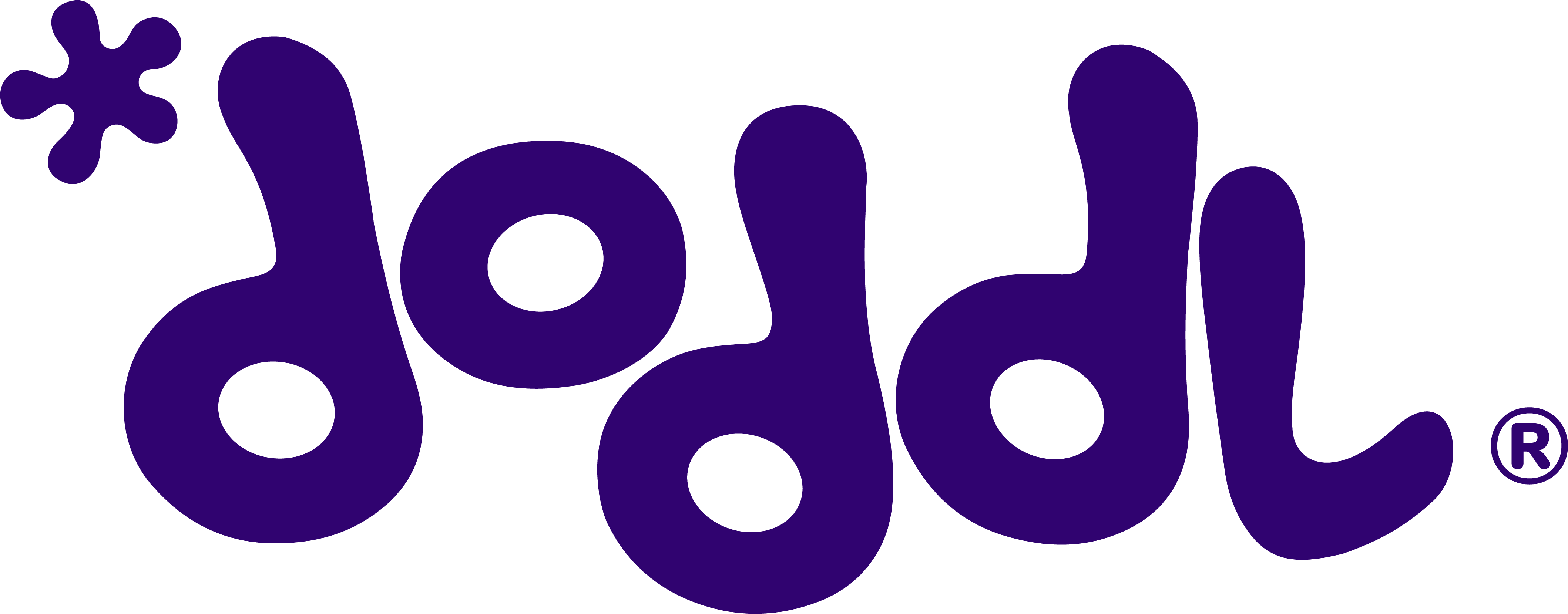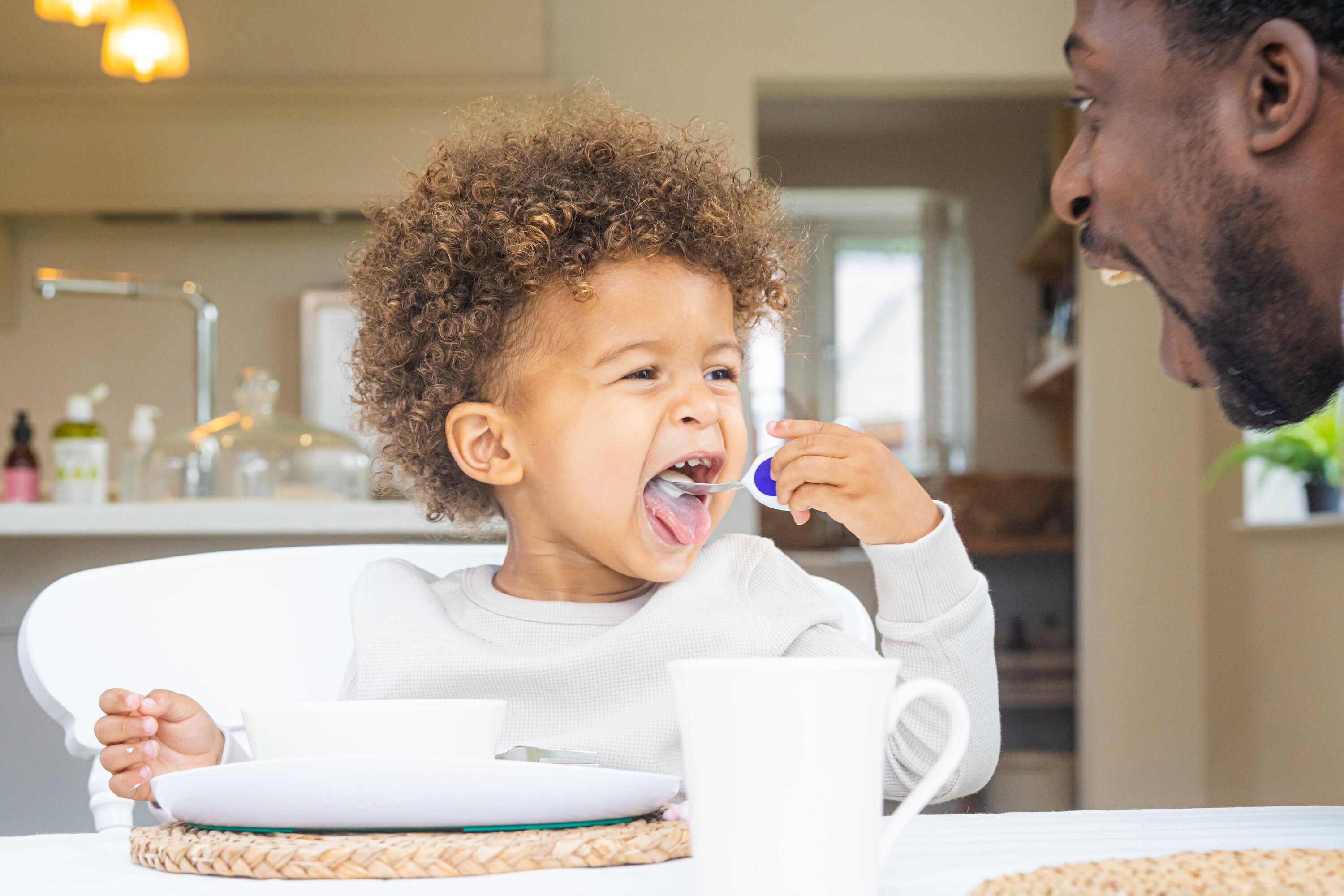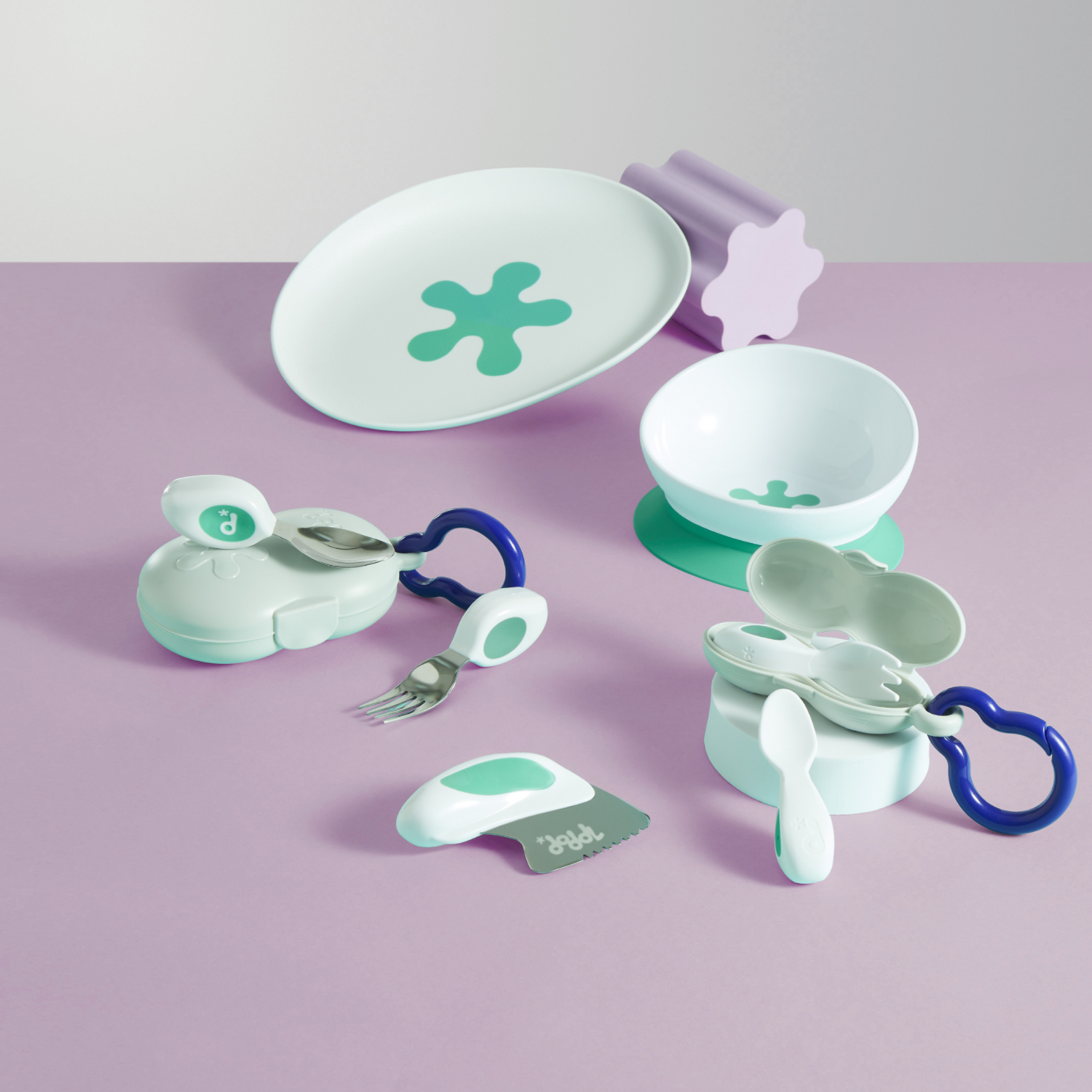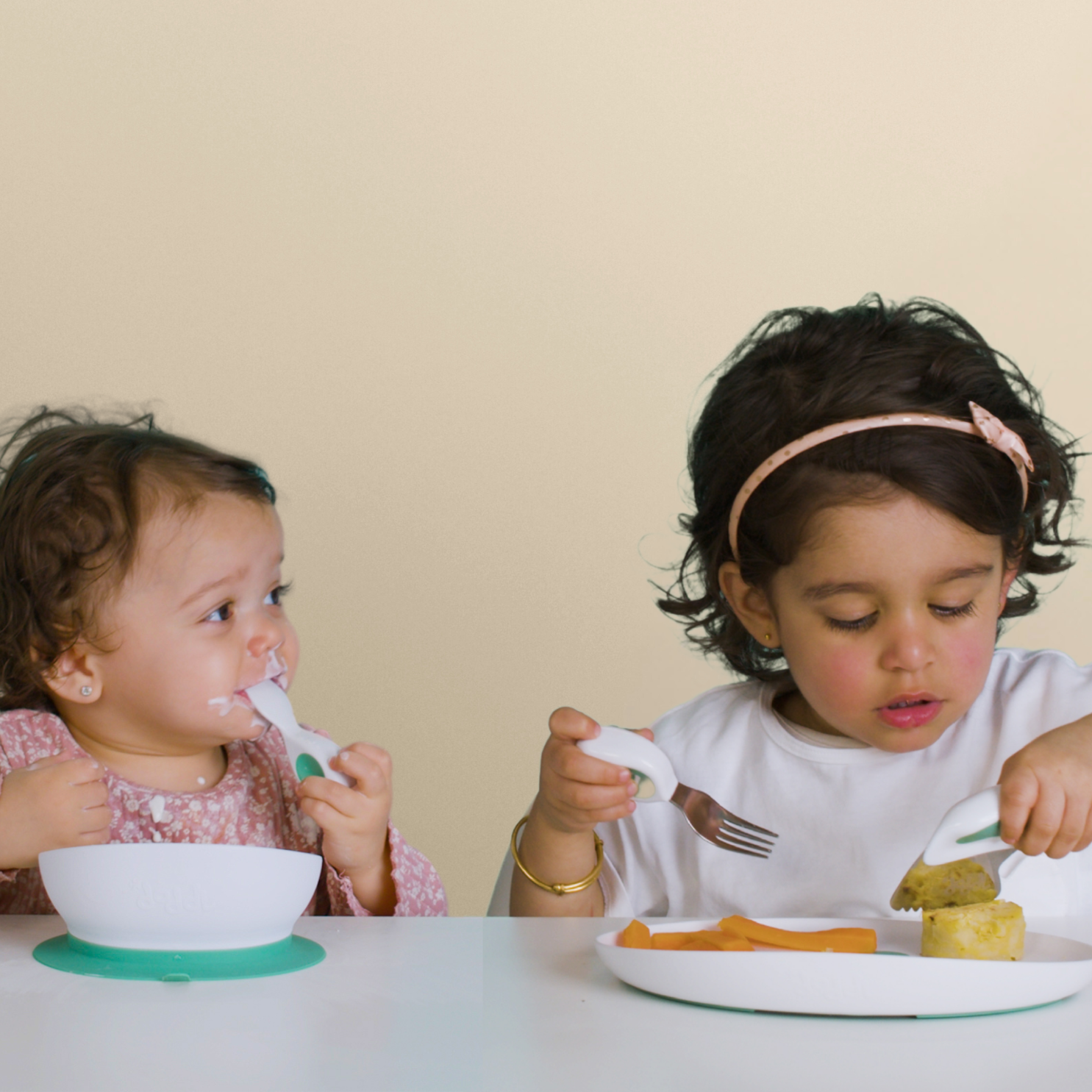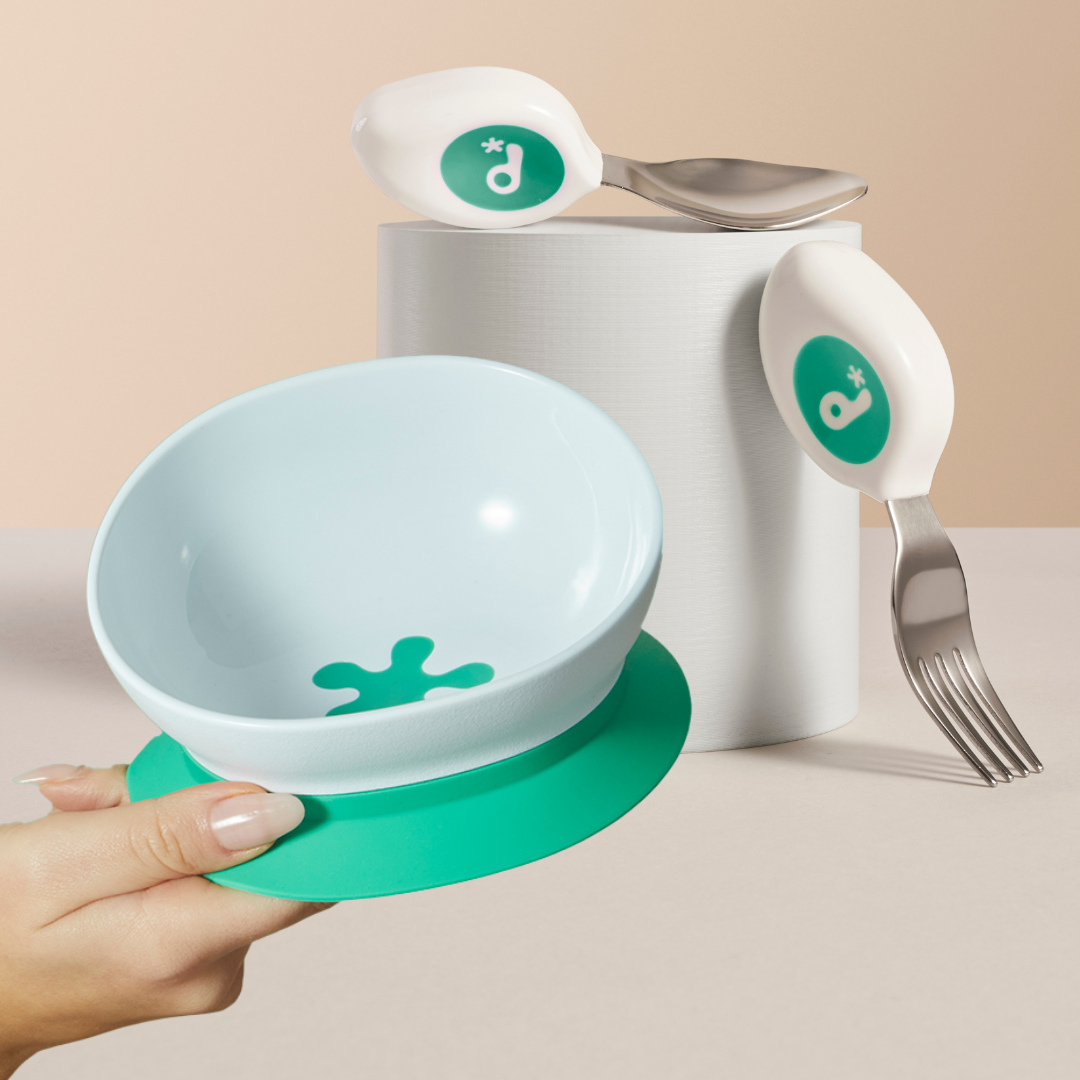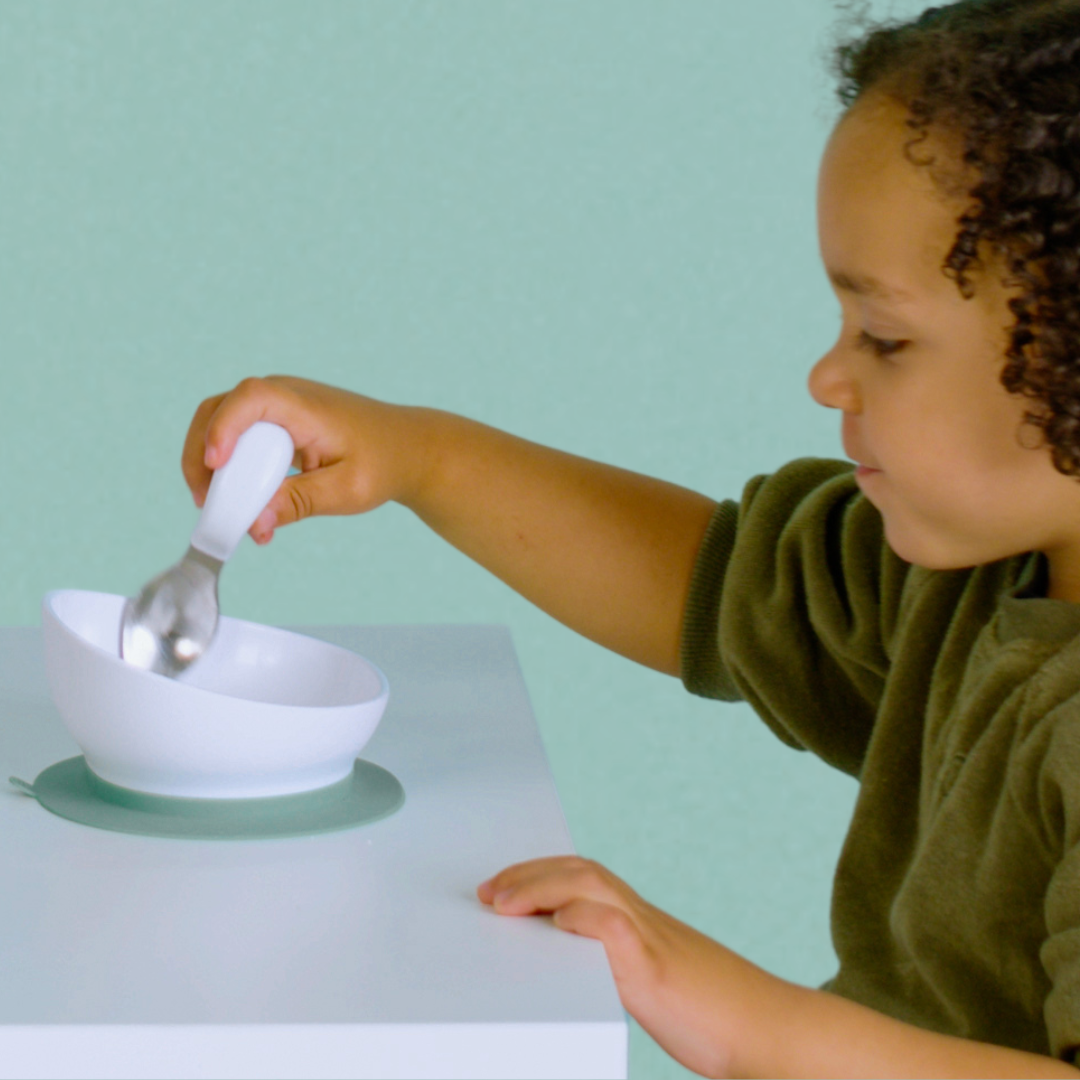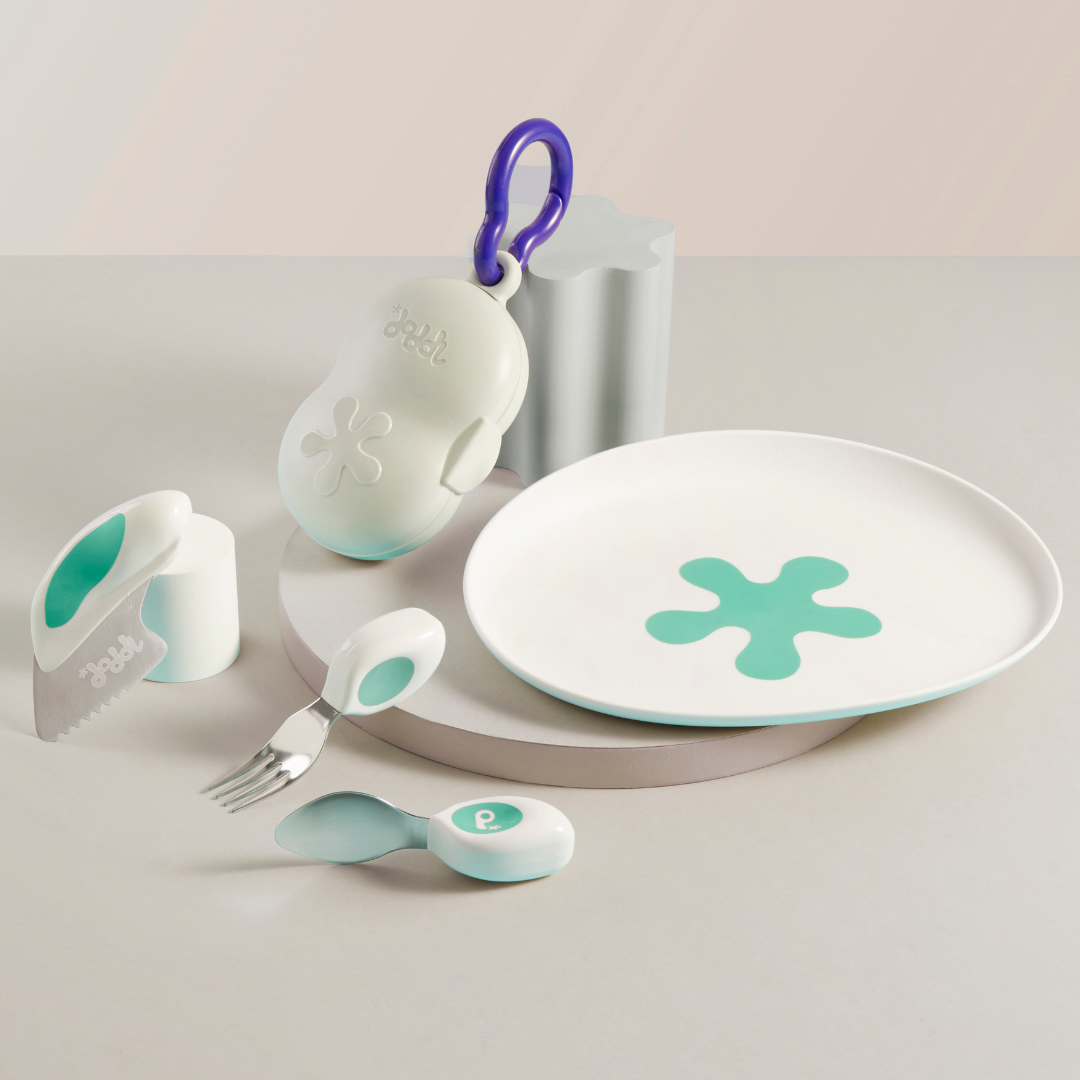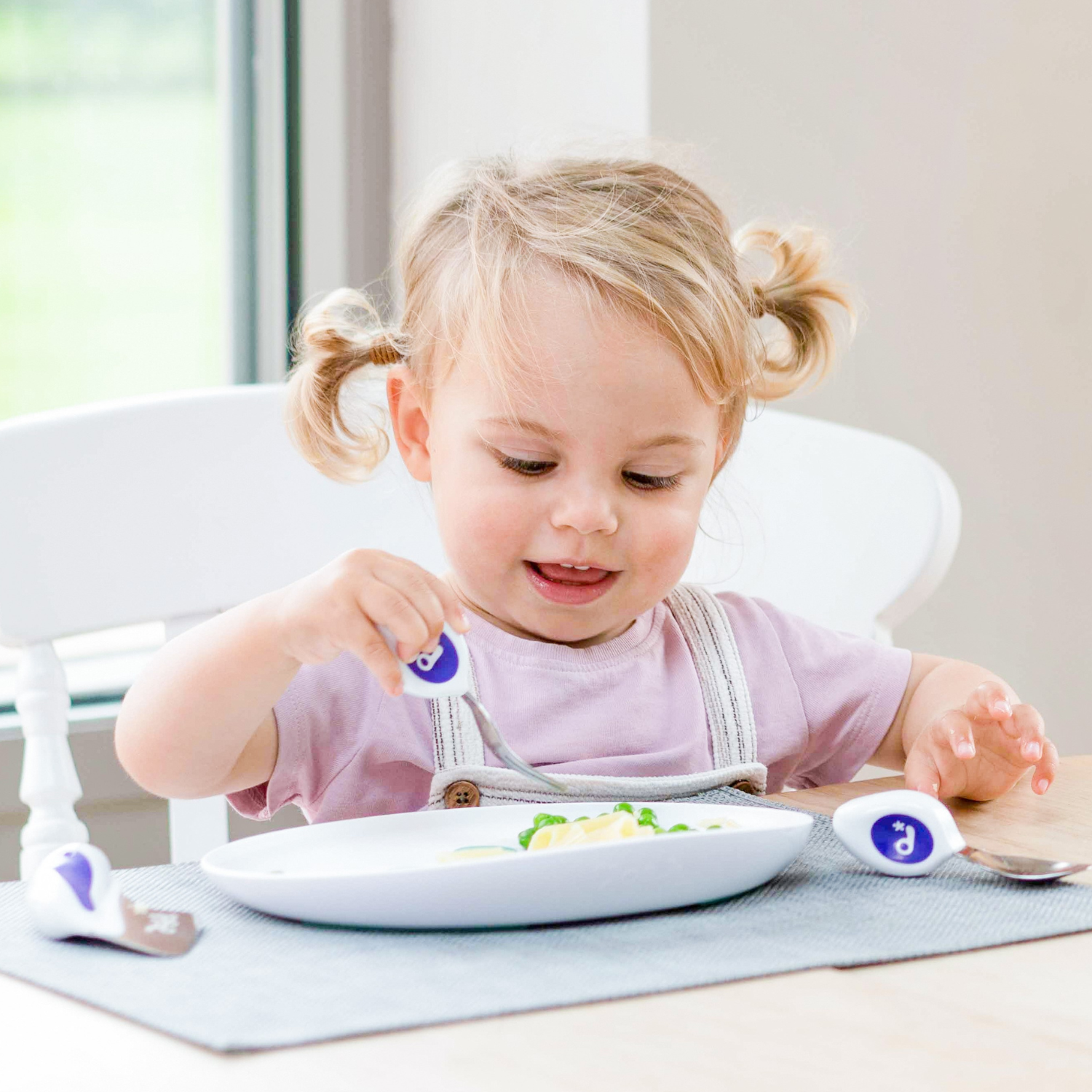FAQs
Help: doddl products
All doddl cutlery sets are cleverly engineered to intuitively teach and train, helping to develop confidence and independence. The difference is in the product size and materials.
doddl baby cutlery is designed for a baby between the age of 6-12 months, it is smaller in size, the handle and utensil ends are made from high quality plastic with soft touch areas.
doddl toddler cutlery is designed for a child 12 months - 5+ years and has high quality plastic handles and soft touch areas, with effective, stainless-steel ends.
If this is the first set of cutlery for your baby and they are under 12 months and are not eating full meals yet, then doddl baby cutlery would be the best first cutlery set for your baby.
If, however, your child is between 11 and 14 months, has some level of co-ordination and is eating more substantial meals, doddl toddler cutlery will be the best set for your child.
Our baby spoons are designed to be intuitive to use, so whatever weaning approach you have decided to take – whether spoon feeding, or baby led weaning or a mixture of both - introducing doddl baby spoons is easy.
- Simply place the baby spoon on the tray/table alongside their food and allow them to explore the baby cutlery.
- Encourage your baby to put the baby spoon to their mouth at each meal – whichever end at first – allowing them to familiarise themselves with the baby cutlery alongside their food.
- Start to load the baby spoon and pass it to them (handle facing them). It’s a completely new skill so be patient, but they will start to put the food to their mouth.
- Babies like to copy, so It’s always helpful if you’re eating with them at the same time.
- Allow them to hold the baby spoon and guide their hand to scoop the food and feed themselves helping them understand the movement from tray/plate to mouth.
Consistency is key so keep offering doddl baby cutlery and you will soon notice your baby’s confidence and skills with cutlery progressing.
Our baby forks are designed to be intuitive to use, so whatever weaning approach you have decided to take with your whether spoon feeding, or baby led weaning or a mixture of both - introducing the doddl baby fork is easy.
- Simply lay the doddl baby fork alongside the food on your baby’s plate or tray and allow them to pick it up and explore.
- Stab a small piece of soft food with the baby fork and encourage
your baby to put it to their mouth. - Once they have mastered this, you can then encourage them to start stabbing the food themselves by holding your hand over theirs and showing them how.
- Babies love to copy, so It’s always helpful if you’re eating with them at the same time.
Consistency is key so keep offering the baby cutlery and you will soon notice your baby’s confidence and skills with cutlery progressing.
Familiarity and development. It’s beneficial for babies to hold a tool in each hand when they’re eating because it helps work both sides of their brains, so even if they are just holding one and using the other, it helps balance the development. It’s also important to familiarise babies with the utensils they will use in the future. Your child won’t always use just a single spoon so beginning early with a 2-piece set is also beneficial for the future.
No, doddl baby cutlery can not be used in a steriliser as this could damage the product.
If you started with doddl baby cutlery, then your baby will have developed the dexterity and control needed to progress, by around 11-12 months. Then it’s more about the size of your baby’s hand and the amount of food they eat. When they are eating more substantial meals doddl toddler cutlery will be more suitable.
The doddl toddler knife is cleverly engineered to work effectively
for a child, making it easy for them to use. The handle sits in your child’s palm, enabling a strong grip and enabling them to use the strength in their hand to push down through food.
- Firstly, show your toddler how the children’s knife works yourself by chopping up a part of their meal or snack whilst reminding them that this is something exciting for them to do themselves.
- Allow your toddler to explore the children’s knife themselves at snack time, mealtime or at playtime (especially if there is playdough around to practice on). Encourage your toddler to hold the toddler knife as you hold your hand over theirs and push down through some 'easy' food, like a banana or cooked carrot.
- Let them try it out for themselves with more 'easy' food. As they begin to chop pieces in two give them plenty of praise. Eating with your toddler is also very helpful, encouraging them to copy you as you chop your dinner.
doddl is designed to be intuitive to use, so introducing the set is easy.
- Simply lay the toddler spoon and toddler fork on the tray/table alongside their food
(handle facing them) and encourage them to pick it up and hold it. - To begin with, load the toddler spoon or toddler fork for them so they can feed themselves - as this becomes more familiar, they will scoop the food by themselves.
- Children like to mimic so eat together as much as possible.
- When you’re both ready, swap out the toddler spoon and introduce the toddler knife. At the start you can hold your hand over theirs and show them how to push the doddl toddler knife down through their food. Then it’s all about honing their skills.
Consistency is key, so use doddl cutlery at every meal and your toddler’s confidence and
independence will continue to grow.
It’s all about the cleverly engineered serrated blade which has been rigorously researched and tested to ensure it is designed to be effective for cutting food, but not skin. With the clever blade design and the power from your child’s palm you’ll find your child can safely chop through any type of food.
Long slim handles from ‘standard’ cutlery are very difficult for young children to grip. They create an awkward movement when trying to navigate the distance from their plate to their mouth. In addition, for babies, they offer an additional ‘gag’ risk – as there is a lot of handle to deal with. Ultimately, they are just small versions of cutlery that has been designed around an adult’s dexterity and control.
Doddl cutlery is engineered to be intuitive for a child to use successfully, unleashing their independence. The handles are short, meaning there is less distance from the food and end of the utensil to the mouth. The contoured handles are also comfortable to hold and help to keep the utensil ends at the correct angle so food stays in place until it reaches its destination.
The handles of both doddl baby cutlery and doddl toddler cutlery are designed to encourage the development of the pincer grip (pinch movement), a key motor skill needed for using zips, scissors, holding pens and pencils. The length of the handles also makes it easier for them to control so they can focus on practicing hand-eye co-ordination. doddl also makes mealtimes more successful which means your child will build confidence quickly and will be able to focus on all the other elements outside of learning to use cutlery, like trying new foods, being sociable and generally enjoying their mealtimes.
Yes all doddl products have been fully safety tested up to the highest standards including EN14372 (European standard) and to FDA standards.
doddl is not suitable for use in a microwave, oven, grill or steriliser.
To keep your doddl cutlery looking beautiful, please wash straight after use, particularly when used with tomato or oil based foods. Avoid corrosive cleaning materials and try not to leave in direct sunlight for long periods as this may cause the soft touch areas to fade.
You can introduce the doddl plate at any age, it is unbreakable, so no need to worry. The doddl plate is a great addition when baby led weaning to lay out your baby’s food so they can see what they are eating, the curve can sit right in front of your baby helping to prevent food falling into their laps and it will help them become familiar with plates from an early age. However, the clever design features really impact when your toddler is practicing with their cutlery. In particular, the gently raised back then helps keep food on the plate and offers your child a surface to push their food against.
The simplest way to do this is to align the small arrows on the suction base and the bowl and whilst keep your thumb pressing down on the arrows, run your finger around the rim. This will reattach the suction with ease.
doddl can be used in a steriliser (not microwave or UV) but is not suitable for use in microwave, oven or grill.
Yes all doddl products are completely BPA and Phthalates free.
All doddl products are free from latex and rubber.
FAQs
Mealtime hints and tips
If you’re just starting to think about weaning, all the information, guidance and advice out there can be overwhelming. The options include spoon feeding, baby led weaning or a mixture of both. At doddl we have years of experience in feeding, so we’ve created a hub of information to help you navigate weaning through to independent eating and everything in between - visit our mealtime matters page or read how to wean your baby
When you choose baby-led weaning you’re essentially skipping purees and spoon
feeding and heading straight to age appropriate finger foods. It's called baby led because that's what the premise is — letting your little one feed themselves a range of different foods, giving them choice about what they select from their tray and giving your baby the opportunity to learn how to chew (or more accurately, gum) first, then swallow. It also prevents us from giving our children too much food, since our babies are in control of how much they put into their mouths. Read more about the benefits of baby led weaning from our blog ‘5 reasons to choose baby led weaning’.
First make sure your baby is ready to start weaning:
- Are they 6 months old?
- Can they sit up unassisted?
- Have they shown an interest in food?
- Are they more hungry than usual?
Once you’re confident it’s the right time, you’ll need to decide what weaning approach you want to take, either baby led weaning, spoon feeding or a mixture of both. You can find this and more in the Mealtime Matters hub.
You can also keep track of your progress with our simple weaning journey markers
As soon as your baby starts to feed, you can introduce appropriate cutlery. Introducing doddl baby cutlery from the start will help your baby become familiar with cutlery as they get used to food and mealtimes. It will help them develop their skills (pincer grip, co-ordination, and dexterity) and helps avoid confusion if cutlery is introduced later, when mealtimes are more established. Simply giving your baby the option is enough at this early stage. Start by placing doddl baby spoons down, handle facing them alongside their food, whatever type of food that is,
and they will start to explore. Picking up the baby spoon, banging it on the table or using their mouth to explore it - both ends - is a great start. You can find out more in the product help section.
You can also read top 4 tops to encourage spoon feeding during weaning.
This very much depends on your child and your situation. There is a lot of evidence that sharing mealtimes with your child is incredibly beneficial to their development. Babies and children love to mimic, it’s a big part of learning, so being able to see how you eat your meals and how you behave during this time will only help in their understanding. The social aspects of mealtimes also offer your child the opportunity to learn; Communication, listening, engaging with others. Important life skills and very helpful when your child eventually starts school and sit with their peers at lunchtime. Finally, there is also evidence to show that happy mealtimes have an impact on your child’s developing relationship with food, and the influence this can have on their future. So, ideally, get your baby around the table as soon as you can, whether in a highchair or in a booster so they can start to feel part of mealtimes.
If you’ve moved your little one from a highchair to a small table – or even to a booster seat at the big table, and you’re finding they consistently try to leave, there are some simple things you can do to help.
Make sure they have equipment that makes it easy for them to succeed, like doddl cutlery, so mealtimes are positive and successful not frustrating and emotional.
Include your child in a family mealtime – so they are not sitting alone eating. Even if you only sit with them while they eat, children love to copy, and if they have no one to copy from, they will struggle to stay engaged.
Give them choice at mealtimes helping them feel independent and ‘grown up’ – whether it is choosing where they sit, or what foods to add to their meal.
Create a mealtime experience that they can be part of – design menus together or place settings or get them involved in the food preparation using the doddl toddler knife.
If you’ve tried all of this and it hasn’t worked, try changing it up completely, do something different to get them out of the habit of leaving the table, create a picnic on the floor, have a ‘grown up’ meal with candles and napkins, pretend to be a waiter and make it a positive and fun experience. Through all of this, try and remember everything is a phase, keep plugging away and you’ll eventually get there.
As frustrating as it is, it’s totally normal for your little one to throw things, including food and it can be a sign of learning. It’s basically cause and effect, I have something, I do X with it (lift my arm and let it go) and Y happens (it lands on the floor). Then there’s the obvious one that it’s their way of communicating they don’t want to be sat in their chair or eating that food.
Find more about this here from Stacey Zimmels 5 tips to stop your toddler throwing food. Obviously, it may be a way of your child getting your attention so, ideally, try not to react to this behaviour. If they are doing it for this and you don’t react, they get nothing for it and they may well stop, helping narrow down the true reason. Try not to over face your child with too much food, if there’s less for them to throw, it may not be as tempting. Create a small area on their tray for foods they don’t like, so you can talk to them about what they did and didn’t like afterwards. Finally remember its more than likely a phase that your little on will grow out of.
In addition to mealtimes with doddl, there are lots of activities you can do to develop your child’s motor skills. You can find some suggested activities in our blog Five fun activities for motor skill development or follow us on social @doddl for ideas
If your spoon-fed baby is now a spoon-fed toddler, how can you foster independent eating? Read how to teach a toddler to feed themselves.
As with all aspects of a toddler, sudden changes to your child’s behaviour can make us question our judgement as to whether we are doing the ‘right thing’. Knowing what to ignore and what to avoid will help.
Find out more here: Feeding toddlers – 6 common mistakes to avoid.
Firstly, try not to compare your weaning or mealtime journey with anyone else’s. However, whilst we all know every child is different, it is natural to look around you and wonder if your little one is making progress in the right way. To help we’ve created some simple mealtime milestones as a guide helping you tick off some challenges (in any order) with your little one so you know you’re heading in the right direction, towards fully independent eating.
It can be worrying when you think your little one isn’t eating as much as you think they should. Paediatric Feeding and Swallowing Specialist Speech Therapist and IBCLC Lactation Consultant Stacey Zimmels from @Feedeatspeak offers advice in her blog Toddler food intake: “My toddler isn’t eating enough, what should I do?"
Dealing with a fussy eater is one of the more frustrating experiences you can have as a parent. Especially when you have spent time and energy thinking about the best kind of food for your child to benefit from. It can also be worrying if you don’t feel your child is eating a variety of food that will set them up well for the future. Read ‘how do I get my fussy eater to eat new foods? And because it’s such a hot topic amongst parents (you’re definitely not the only one to experience this) we asked Family Consultant at Bespoke Family, Clare Burgess to share her hints and tips about 'fussy' 'picky' choosy' eaters'.
We all want to have children that will be adventurous with their foods, and whilst we probably all recognise it’s not as simple as presenting it to them and watching them eat, there are some simple things you can do right at the start of weaning to help. Claire Burgess from Bespoke Family offers some insights in her blog the next stage – real food, textures and tastes
There is real power in establishing positive mealtimes for children, from lifelong health benefits to social & development opportunities. On a daily basis, mealtimes offer the opportunity for us to help children develop and unleash their independence. So whilst there are many routines in life that we do without too much consideration – at doddl we really believe mealtimes shouldn’t be one of them. Sitting around as a family or friend group and chatting about the day as you eat your meal may not seem like a learning opportunity, but it is for your child. Routinely they are experiencing how we interact around each other at the table, how we eat while we engage with each other, how we treat each other, how we behave. By sitting together, your child will also see you eating all different types of foods which will ultimately open their eyes to the variety of foods on offer. For more about the benefits of the whole mealtime experience read make mealtimes about the experience not just the food.
The simple answer is yes, because there are all kinds of benefits for both you and your child– for more insights read the importance of eating out with your children from family Consultant Claire Burgess.
Visit weaning recipes for babies or toddler food recipes for some healthy ideas.
At doddl we have spent years working with experts as we have researched, developed, and tested our products and along the way have learned a lot about feeding and mealtimes. We partner with experts to help provide the very best advice. Mentioned in our hints and tips section are:
Claire Burgess a Family consultant and Early Years Expert at Bespoke Family and previously partnered with doddl whilst at the Norland College.
Stacey Zimmels from Feed Eat Speak is a feeding & swallowing specialist and Speech and Language Therapist.
Lucy Upton from The Children’s Dietician is a Specialist Paediatric Dietitian
